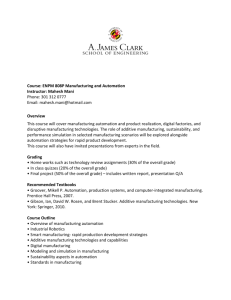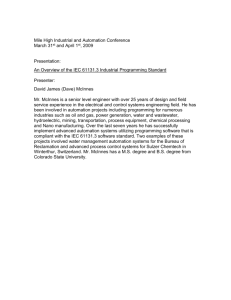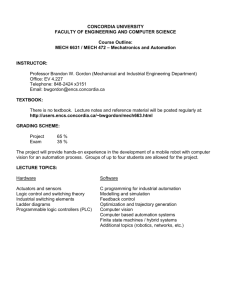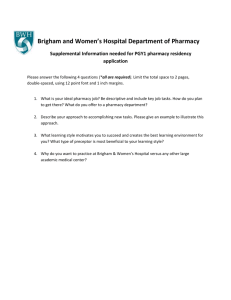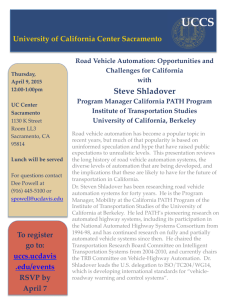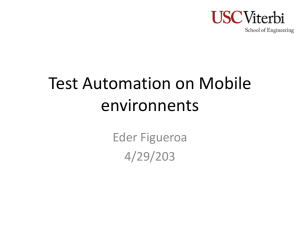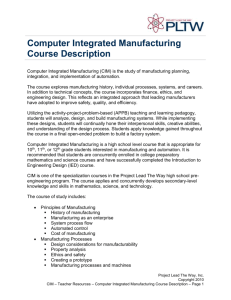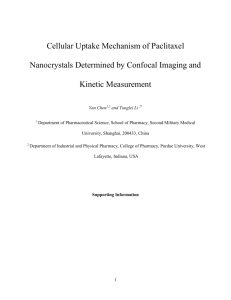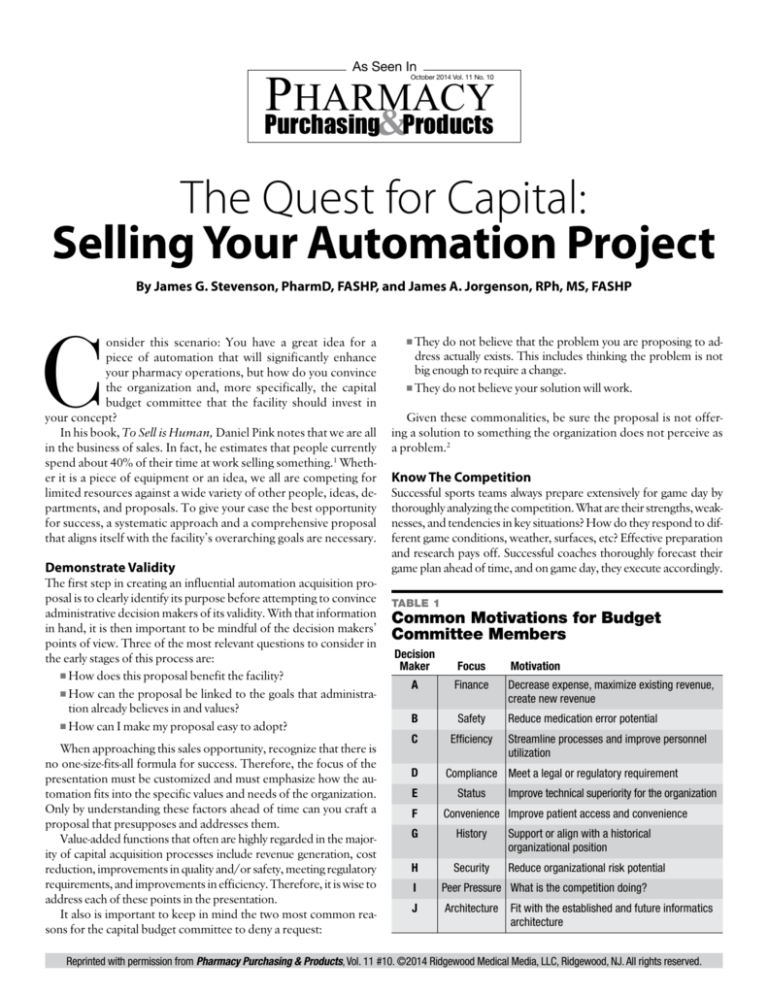
As Seen In
P
harmacy
Purchasing Products
October 2014 Vol. 11 No. 10
&
The Quest for Capital:
Selling Your Automation Project
By James G. Stevenson, PharmD, FASHP, and James A. Jorgenson, RPh, MS, FASHP
C
onsider this scenario: You have a great idea for a
piece of automation that will significantly enhance
your pharmacy operations, but how do you convince
the organization and, more specifically, the capital
budget committee that the facility should invest in
your concept?
In his book, To Sell is Human, Daniel Pink notes that we are all
in the business of sales. In fact, he estimates that people currently
spend about 40% of their time at work selling something.1 Whether it is a piece of equipment or an idea, we all are competing for
limited resources against a wide variety of other people, ideas, departments, and proposals. To give your case the best opportunity
for success, a systematic approach and a comprehensive proposal
that aligns itself with the facility’s overarching goals are necessary.
Demonstrate Validity
The first step in creating an influential automation acquisition proposal is to clearly identify its purpose before attempting to convince
administrative decision makers of its validity. With that information
in hand, it is then important to be mindful of the decision makers’
points of view. Three of the most relevant questions to consider in
the early stages of this process are:
n How does this proposal benefit the facility?
n How can the proposal be linked to the goals that administration already believes in and values?
n How can I make my proposal easy to adopt?
When approaching this sales opportunity, recognize that there is
no one-size-fits-all formula for success. Therefore, the focus of the
presentation must be customized and must emphasize how the automation fits into the specific values and needs of the organization.
Only by understanding these factors ahead of time can you craft a
proposal that presupposes and addresses them.
Value-added functions that often are highly regarded in the majority of capital acquisition processes include revenue generation, cost
reduction, improvements in quality and/or safety, meeting regulatory
requirements, and improvements in efficiency. Therefore, it is wise to
address each of these points in the presentation.
It also is important to keep in mind the two most common reasons for the capital budget committee to deny a request:
hey do not believe that the problem you are proposing to adT
dress actually exists. This includes thinking the problem is not
big enough to require a change.
n They do not believe your solution will work.
n
Given these commonalities, be sure the proposal is not offering a solution to something the organization does not perceive as
a problem.2
Know The Competition
Successful sports teams always prepare extensively for game day by
thoroughly analyzing the competition. What are their strengths, weaknesses, and tendencies in key situations? How do they respond to different game conditions, weather, surfaces, etc? Effective preparation
and research pays off. Successful coaches thoroughly forecast their
game plan ahead of time, and on game day, they execute accordingly.
Table 1
Common Motivations for Budget
Committee Members
Decision
Maker
Focus
Motivation
A
Finance
Decrease expense, maximize existing revenue,
create new revenue
B
Safety
Reduce medication error potential
C
Efficiency
D
E
F
Streamline processes and improve personnel
utilization
Compliance Meet a legal or regulatory requirement
Status
Improve technical superiority for the organization
Convenience Improve patient access and convenience
G
History
Support or align with a historical
organizational position
H
Security
Reduce organizational risk potential
I
Peer Pressure What is the competition doing?
J
Architecture
Fit with the established and future informatics
architecture
Reprinted with permission from Pharmacy Purchasing & Products, Vol. 11 #10. ©2014 Ridgewood Medical Media, LLC, Ridgewood, NJ. All rights reserved.
Table 2
Sample WIIFT Table: Proposal for an Automated Packaging and Dispensing System
Decision
Maker Focus
A
Finance
WIIFT
Data Needed
(Current State vs Automated State)
• Decrease expenses
• Cost of personnel time saved
• Increase revenue generation
• Cost of purchasing UD meds vs bulk meds for repackaging
• Cost of outsourced packaging
• Cost of ADEs associated with med errors
• Waste from expired repackaged meds
• Revenue opportunities from repurposed pharmacist time
B
Safety
• Reduce medication error potential
• Med error rates/types
C
Efficiency
• Streamline processes
• Packaging time
• Improve personnel utilization
• UD cart fill and check time
• Returned med processing time
• Nursing med pass time
D
Compliance
• Meet a legal or regulatory requirement
• Opportunity to eliminate pharmacist checks of robot
packaged/dispensed meds
E
Status
• Improve technical superiority for the organization
• Public relations opportunity around robotic accuracy
F
Convenience
• Improve patient access and convenience
• Reduced turnaround time for first doses
G
History
• Support or align with an historical organizational position
• Complement organizational digital strategy
H
Security
• Reduce organizational risk potential
• Reduced risk for packaging and dispensing errors
I
Peer Pressure • What is the competition doing?
J
Architecture
• Any competitors with similar technology?
• Fit with the established and future informatics architecture • Complement overall technology architecture
Approaching a budget committee is, in effect, a competition.
The pharmacy is competing for limited dollars against others in the
organization. Thus, success depends heavily on understanding both
your opponents and the playing field. Consider the following in
your preparations:
n How much total funding is available?
n How much of the available funding is earmarked for other projects (eg, capital replacements or informatics infrastructure)?
n Is it better to propose multiple or multiphase projects, or
should the focus be on a single device?
n What projects am I competing against and how does their value
proposition compare to that of my proposed automation?
n How does the organization approach funding for projects?
Do they value purchasing? Do they consider capital leasing options?
n Are there operating expenses associated with the proposed capital purchase?
n How does the organization approach maintenance contracts?
n Is the committee favorably inclined to use external resources,
such as consultants, to supplement a project?
By carefully analyzing the opposition, pharmacy can work to
craft an automation proposal that positively positions the desired
technology relative to the competition and gives it the best chance
of success.
Understand the Committee’s Motivations
Prior to generating any proposals, the best sales professionals determine what will excite or motivate their target audience to care about
their idea. In doing so, they identify the what’s in it for them (WIIFT)
elements that will convince the decision makers of the concept’s
value.3 When budget committee members consider the various ideas
that come before them, they immediately try to determine what they
will gain by approving a proposal. In most cases, a capital budget committee comprises professionals with different backgrounds, interests,
goals, and WIIFTs. To be most effective, pharmacy should work to
understand each of the target audience members and his or her likely
WIIFTs by considering the following questions:
n Does the automation solution address an important need?
n Is it distinctive in comparison to competing proposals?
n Does it offer advantages over competing proposals?
nI
s it compatible with previous decisions made by the organization?
n Does it fit with the current and future organizational structure?
A simple, but effective, exercise is to construct a chart to organize
the focus and WIIFTs (or motivations) of each of the target audience
members (see Table 1).
Once the WIIFTs of all committee members have been established, you can build your proposal around these elements. As an example, a WIIFT table for a proposal for an automated packaging and
dispensing system might look like Table 2.
It is important to focus on the benefits of your idea, rather than
the features or functions of the automation. Features are the technical capabilities of the automation, whereas functions are what
the features deliver, and benefits are the positive outcomes of what
the functions produce.3 Decision makers on a budget committee
generally are not highly involved in the daily workflow of the pharmacy and tend to be less interested in specific features and functions. Rather, they will base their decision on the potential benefits
the purchase will bring to the pharmacy and to the institution as a
whole.
Emphasize Ease of Adoption
A key element for decision makers in selecting from among competing proposals is ease of adoption. Therefore, it is wise to present the automation proposal in easily understandable, lay terms
and to avoid detailing complex implementation steps. It is difficult to sell an automation idea that requires significant customization to fit into the organization’s established informatics and
automation architecture. The more complex the automation proposal, the less inclined the decision makers will be to approve it.
Conversely, emphasizing how the automation will integrate readily with established systems will increase the likelihood of success.
Know and be candid about the resources necessary for the
implementation and utilization of the automation. In your preparations, consider whether the project will require a significant
amount of internal resources, such as informatics specialists or
biomedical engineering. Quite often, hospital informatics departments (IT) are stretched thin with little capacity for new projects,
so automation proposals that require extensive interfaces or other
informatics support are often passed over for simpler alternatives.
Proactively address how internal resources, such as IT, can be
conserved and work to procure support from any affected departments before presenting the case for your project. Consider the
following:
n Can external resources be contracted to supplement internal resources for implementation?
n Will the automation ultimately improve efficiency and utilization of current resources?
n Will the project require a significant investment in full-time
employees?
It is important to address staffing requirements as part of a
larger discussion about the overall value of the technology. In other words, the cost of any additional personnel should be netted
against the projected and ongoing value of the automation. Consider whether any special expertise will be necessary to implement
and/or operate the automation. Will this require hiring specially
trained experts, or can internal personnel be trained to meet these
needs? If so, what are the costs associated with that training?
Making The Case
With the baseline research complete and a strong understanding of
the WIIFTs and values of each of the budget committee members,
the final step is to create a strong presentation that will seal the deal.
The best sales professionals are invariably good closers; they understand that facts and figures alone will not secure the sale. Making a
connection with the decision makers and presenting a memorable
case that demonstrates why the proposal is the best among its competition will go a long way in gaining approval.
When presenting to the budget committee:
n Stay focused. State up front what you are going to do: In my
15 minutes, I am going to convince you that investing in this
pharmacy automation technology is a wise decision for our
organization.
nU
se experts to support your case. If a well-respected internal leader believes in your proposal, rely on their endorsement to help make your position more credible. Are there
outside groups that the organization considers reliable information sources that have taken a positive position on your
proposed automation solution? For example, if a piece of automation impacts medication safety, an organization with a
position on the problem and potential solutions, such as the
Institute for Safe Medication Practices, might be a good external reference source.
nP
resent data effectively. Facts and figures are most compelling when they focus on the elements that the decision makers
have deemed most relevant.
nF
ocus on return on investment (ROI). ROI is another powerful motivator for most budget committees, so be sure to develop a credible ROI model. If possible, review the model with
a finance expert who can critique your assumptions prior to the
presentation. You can then underscore this external validation
by the financial expert when you present your case. If the automation investment will deliver an ROI in less than 12 months,
you have a strong point to leverage.
nA
nticipate roadblocks. Be prepared to address any challenges the committee may raise. For example, if the committee
cites a lack of capital, is there a way to phase in the proposed
solution in order to bridge a capital cycle? Come to the meeting
with a Plan B so you do not have to wait until the next committee meeting to respond to any roadblocks.
nU
se stories to connect emotionally. One of the best ways
to connect with decision makers is to share examples or anecdotes from your organization to demonstrate the impact the
proposed automation can impart. If you are suggesting a piece
of technology to improve patient safety, relate that to an error
that occurred in your facility. Although you can augment this
with national error rates and others’ experiences, keep in mind
that many organizations resist learning from the mistakes of
others; errors are sometimes only instructive when they happen at your facility.
nB
uild on past successes. Build on the trust pharmacy has
engendered through a positive track record with other projects. If the decision makers have invested successfully in pharmacy on previous occasions, remind them of those positive
experiences.
nD
o your homework. Inform the committee of additional
alternatives you explored. This helps to increase their confidence that you have done all appropriate due diligence before
presenting your solution as the best option.
nA
ddress scalability. A detailed explanation of how the solution can be scaled up over time will give the committee confidence that it is sufficiently flexible to meet future demands.
Delineate any risks associated with the project and outline
what you will do to mitigate them to further engender their
trust in your decision.
nC
onsider time sensitivity. Is the proposed technology
time-sensitive in any way? For example, does the technology
address impending regulatory issues? What is the downside
or potential cost of not taking prompt action? If there is a
safety aspect associated with the technology, what is the risk
profile impact of not acting? Explore benchmarking opportunities to support your case.
Finally, like any superior salesperson, close by specifically asking for the committee’s commitment or at least a specific date by
which you will receive a response. Before you leave the room, ensure that all of the committee members’ questions have been fully
addressed.
tation succinct and focused on expected benefits, and illustrating
it with facility-specific stories, will help you connect with the decision makers and increase the likelihood of a positive decision in this
competitive funding environment. n
References
1. Pink DH. To Sell Is Human: The Surprising Truth About Moving Others. New
York, NY: Riverhead Books; 2012.
2. How to Close a Sale. Inc.com Web site. http://www.inc.com/guides/2010/05/
closing-the-sale.html. Updated May 18, 2010. Accessed June 24, 2014.
3. Daly JA. Advocacy: Championing Ideas and Influencing Others. New Haven,
CT: Yale University Press; 2011.
Practice Your Presentation
Give the presentation to other stakeholders to make certain your
proposition is clear and that you can deliver the proposal effectively. Consider including the prospective automation vendor in
your practice sessions; vendors tend to not only have a wealth of
experience and product knowledge, but also a perspective that is
especially sensitive to ROI for the organization.
Making an effective and compelling case for pharmacy automation is a critical skill for pharmacy leaders. The art of selling your
idea starts with understanding the values of those on the budget
committee who will be deciding how to allocate limited capital resources. Diagnosing their WIIFTs is a critical step toward convincing decision makers of the institutional benefits of the proposed
technology. Support from influential internal and external experts
is helpful, as is an endorsement by a finance authority regarding
your ROI model and its assumptions. Finally, keeping the presen-
James G. Stevenson, PharmD, FASHP, is president
of hospitals and health systems services at Visante,
Inc, in St. Paul, Minnesota. Before joining Visante, Stevenson was chief pharmacy officer at the University
of Michigan Health System and associate dean and department
chair of clinical, social, and administrative sciences at the University of Michigan College of Pharmacy.
James A. Jorgenson, RPh, MS, FASHP, is chief executive officer and chairman of the board of Visante, Inc,
and Visante Limited. Before joining Visante, Jim was
chief pharmacy officer and vice president of Indiana University Health, where he was responsible for the design and operation of the system’s pharmacy services supporting IU Health’s
integrated delivery network.
swisslog.com/healthcare
Reprinted with permission from Pharmacy Purchasing & Products, Vol. 11 #10. ©2014 Ridgewood Medical Media, LLC, Ridgewood, NJ. All rights reserved.

